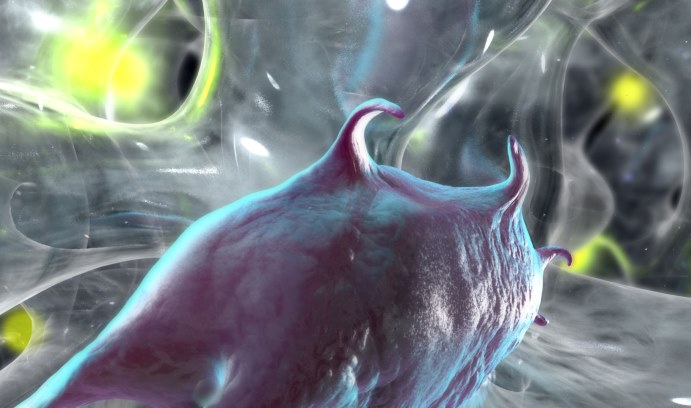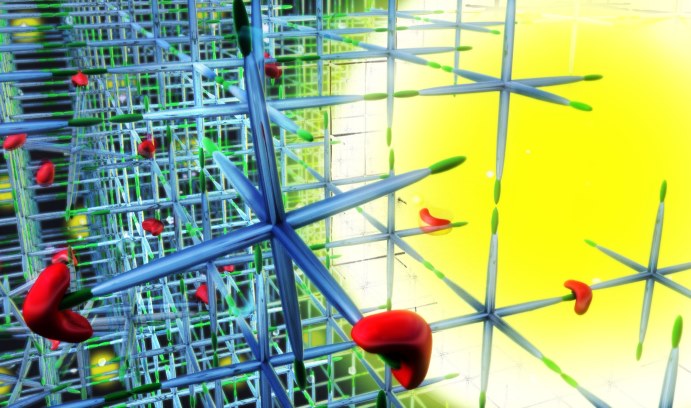Engineering Cells to Speed Tissue Repair

Kelly Schultz explores how cells remodel their microenvironment in a push toward faster wound healing and tissue regeneration. (Illustration by Nicholle R. Fuller)
Replacing and repairing human tissue is becoming feasible largely due to advances in the use of stem cells. But obstacles still stand in the way of engineering these malleable cells to self-renew or expand.
One of those obstacles is an incomplete picture of how cells interact with their environment.
“Cells do not simply reside within a material, they actively reengineer it,” says Kelly Schultz, the P.C. Rossin Assistant Professor of Chemical and Biomolecular Engineering. “Characterizing how cells behave in 3D synthetic material is critical to advancing the design of biomaterials used in wound healing, tissue engineering and stem cell expansion.”

Schultz recently received a three-year grant from National Institutes of Health (NIH) to study how cells remodel their microenvironment—a crucial step toward engineering cells to move through synthetic material and tissue more quickly for faster wound healing and tissue regeneration.
Schultz will build on previous work in which she and her colleagues revealed that during attachment, spreading and motility, cells degrade material in the pericellular region directly around the cell in an entirely different manner than researchers had previously believed. The results were published in an article in the Proceedings of the National Academy of Sciences (PNAS).
Before Schultz’s earlier study, scientists believed cells moved through material while simultaneously degrading it—like Pac Man gobbling up dots while moving through a video game maze.
Utilizing microrheology, a technique that measures the properties and states of matter, Schultz and her colleagues made a discovery that overturned this notion. After encapsulating mesenchymal stem cells in a hydrogel, the team measured dynamic interactions between the cells as they moved through material.
They made an unexpected observation: the cells pause before moving. They discovered that from a stationary position, Point A, a given cell secretes an enzyme. They hypothesize that the enzyme is bound with an inhibitor that temporarily stops the enzyme from degrading the material while it’s being sent to Point B. Starting at Point B, the enzyme begins to “gobble up” the material that surrounds the cell. Only then does the cell move on to its next location.
The inhibitor, the team observed, prevents the enzyme from degrading the material while the cell is secreting it.
Armed with this information, Schultz and her team now aim to “inhibit the inhibitor.” That is, they seek to identify which inhibitor, or combination of inhibitors, is responsible for stopping the enzyme from degrading the material while it’s being secreted. Once identified, the researchers hope to “tune” the inhibitor to shut off during secretion so that the cell will move through and degrade the material faster.
Engineering the cell to move faster is important for wound healing, Schultz says. The sooner the cells arrive at the wound site, the sooner they can start to regenerate the tissue.
“Our goal is to prevent the cell from stalling, encouraging it to become active right away and arrive at the wound site at twice the speed,” said Schultz.
(An animation by Nicolle Fuller/Sayo-Art LLC shows how cells remodel their natural environment.)
A scaffold to mimic bone
With broad implications for biomaterial design, Schultz’s project will focus on a range of tissues, from adipose to bone, to measure how changing the physical environment might alter the strategies cells use to degrade the material. She works with mesenchymal stem cells—a type of adult stem cell that has the ability to differentiate into a variety of cell types.
Hydrogel offers two advantages. First, it mimics tissue well, providing an ideal physical environment to characterize cell behavior in 3D. Hydrogels are more than 90 percent water, are very porous and can be “tuned” to change properties to mimic anything from bone to fat.
Second, once the hydrogel is implanted in a human, it can be used as a scaffold to restructure a wound of a size that the body cannot heal.
“For example, if a patient is missing a piece of bone that is too large to heal—or regenerate—on its own, a hydrogel structure can be implanted,” said Schultz. “Inside the structure are stem cells that have been given an environment that would push them down a lineage into bone cells. Once implanted the stem cells reproduce themselves, ‘filling in’ the part of the bone that is missing. While the bone is growing outside the implant, new tissue is growing on the inside—speeding healing. As the bone regenerates, the implant disintegrates.”
To make the hydrogel structures, Schultz mixes polymers, peptides, stem cells and microparticles. The microparticles enable the material properties of the hydrogel to be measured during cell-mediated degradation.
“We take videos of the microparticles and observe their movement,” said Schultz. “The amount they wiggle reveals their properties and enables us to see spatially what’s occurring. That is how we characterized the unexpected degradation profile.”
“Inhibiting the inhibitor”
The recording process described above is known as multiple particle tracking microrheology. This same method will be used to identify the role of inhibitors.
Cells secrete four different enzyme inhibitors, called tissue inhibitor of metalloproteinases (TIMPs). The researchers will inhibit each to discover which one is responsible for stopping the material degradation, or if it is a combination of them.
Schultz and her collaborators will also mimic diverse tissue types in order to observe how the inhibitors might change depending on the material.
Schultz’s studies will focus on the remodeling of synthetic scaffolds by human mesenchymal stem cells. The techniques and strategies she and her team develop are expected to contribute to the understanding of cell-material interactions and to identify how these interactions can be exploited to manipulate cellular behavior for 3D cell culture platforms and tissue regeneration applications.
Among the nation’s brightest
Schultz is one of engineering’s rising stars, according to the prestigious National Academy of Engineering (NAE).
This September, she will participate in the NAE’s 22nd annual U.S. Frontiers of Engineering (USFOE) symposium. The symposium recognizes engineers ages 30-45 who are performing exceptional research in a variety of disciplines. Schultz was one of 83 engineers from industry, academia and government to be nominated and selected for the impact of their work.
“The USFOE symposium gives our nation’s brightest younger engineers the opportunity to engage, collaborate, and develop long-term relationships that are critical to advancing our nation’s future,” said NAE President C. D. Mote, Jr. in a statement.
Posted on:






